engine RENAULT WIND 2012 1.G Owner's Manual
[x] Cancel search | Manufacturer: RENAULT, Model Year: 2012, Model line: WIND, Model: RENAULT WIND 2012 1.GPages: 185, PDF Size: 5.52 MB
Page 70 of 185

fueladvice on fuel economy .................. (up to the end of the DU)
practical advice ..................................... (up to the end of the DU)
fuel economy ........................................ (up to the end of the DU)
filter air filter ............................................................. (current page)
filter diesel filter ........................................................ (current page)
driving ................................................... (up to the end of the DU)
maintenance .......................................................... (current page)
antipollution advice ............................................. (up to the end of the DU)
2.6
ENG_UD20551_2
CONSEILS : antipollution, économies de carburant, conduite (E33 - X3\
3 - Renault)
ENG_NU_865-6_E33_Renault_2
Jaune NoirNoir texte
Advice on antipollution and fuel economy
ADVIcE: antipollution, fuel economy and driving (1/3)
By virtue of its design, moderate fuel
consumption and initial settings, your
vehicle conforms to current antipol-
lution regulations. The manufacturer
is actively striving to reduce pollutant
exhaust gas emissions and to save
energy. But the fuel consumption of
your vehicle and the level of pollutant
exhaust gas emissions are also your
responsibility. Ensure that it is main -
tained and used correctly.Maintenance
It is important to remember that failure to
respect antipollution regulations could
lead to legal action being taken against
the vehicle owner. In addition, replacing
engine, fuel supply system and exhaust
components with parts other than those
originally recommended by the manu -
facturer may alter your vehicle so that
it no longer complies with antipollution
regulations.
Have your vehicle adjusted and
checked by an approved Dealer, in ac-
cordance with the instructions given in
your maintenance schedule: they will
have all the equipment necessary for
ensuring that your vehicle is maintained
to its original standard.
Engine adjustments
– ignition: this does not require ad -
justment.
– spark plugs: for optimum fuel econ-
omy, efficiency and performance
the specifications laid down by our
Design Department must be strictly
applied.
If the spark plugs have to be
changed, use the make, type and
gap specified for your vehicle’s
engine. Contact an approved dealer
for this.
– idle: this does not require adjust -
ment.
– air filter: a choked element will
reduce efficiency. It must be re -
placed.
Page 71 of 185
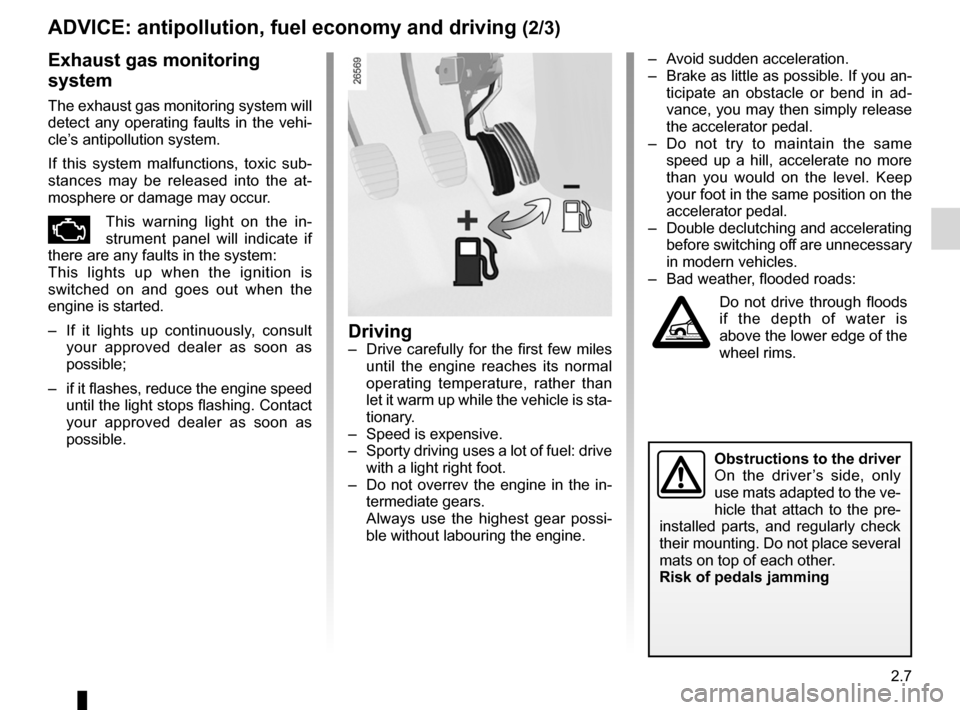
JauneNoirNoir texte
2.7
ENG_UD20551_2
CONSEILS : antipollution, économies de carburant, conduite (E33 - X3\
3 - Renault)
ENG_NU_865-6_E33_Renault_2
ADVIcE: antipollution, fuel economy and driving (2/3)
Driving
– Drive carefully for the first few miles
until the engine reaches its normal
operating temperature, rather than
let it warm up while the vehicle is sta-
tionary.
– Speed is expensive.
– Sporty driving uses a lot of fuel: drive
with a light right foot.
– Do not overrev the engine in the in-
termediate gears.
Always use the highest gear possi -
ble without labouring the engine.
Exhaust gas monitoring
system
The exhaust gas monitoring system will
detect any operating faults in the vehi-
cle’s antipollution system.
If this system malfunctions, toxic sub -
stances may be released into the at -
mosphere or damage may occur.
ÄThis warning light on the in -
strument panel will indicate if
there are any faults in the system:
This lights up when the ignition is
switched on and goes out when the
engine is started.
– If it lights up continuously, consult
your approved dealer as soon as
possible;
– if it flashes, reduce the engine speed
until the light stops flashing. Contact
your approved dealer as soon as
possible. –
Avoid sudden acceleration.
– Brake as little as possible. If you an-
ticipate an obstacle or bend in ad -
vance, you may then simply release
the accelerator pedal.
– Do not try to maintain the same
speed up a hill, accelerate no more
than you would on the level. Keep
your foot in the same position on the
accelerator pedal.
– Double declutching and accelerating
before switching off are unnecessary
in modern vehicles.
– Bad weather, flooded roads:
Do not drive through floods
if the depth of water is
above the lower edge of the
wheel rims.
obstructions to the driver
On the driver ’s side, only
use mats adapted to the ve-
hicle that attach to the pre-
installed parts, and regularly check
their mounting. Do not place several
mats on top of each other.
Risk of pedals jamming
Page 72 of 185
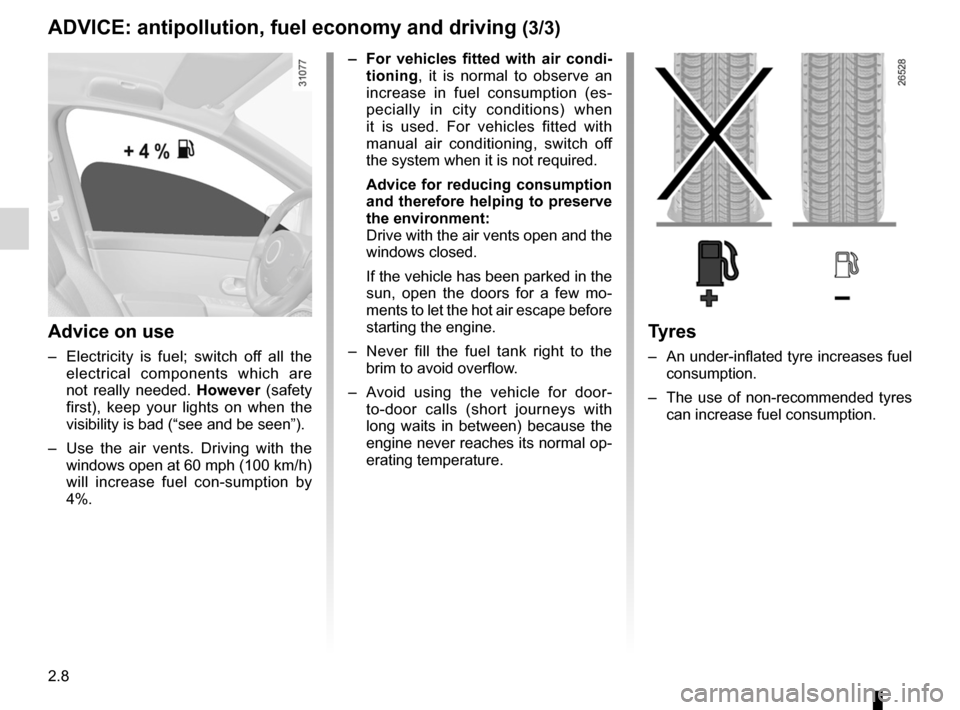
tyres ....................................................................... (current page)
2.8
ENG_UD20551_2
CONSEILS : antipollution, économies de carburant, conduite (E33 - X3\
3 - Renault)
ENG_NU_865-6_E33_Renault_2
ADVIcE: antipollution, fuel economy and driving (3/3)
Advice on use
– Electricity is fuel; switch off all the
electrical components which are
not really needed. however (safety
first), keep your lights on when the
visibility is bad (“see and be seen”).
– Use the air vents. Driving with the
windows open at 60 mph (100 km/h)
will increase fuel con -sumption by
4%.
– For vehicles fitted with air condi -
tioning , it is normal to observe an
increase in fuel consumption (es -
pecially in city conditions) when
it is used. For vehicles fitted with
manual air conditioning, switch off
the system when it is not required.
Advice for reducing consumption
and therefore helping to preserve
the environment:
Drive with the air vents open and the
windows closed.
If the vehicle has been parked in the
sun, open the doors for a few mo -
ments to let the hot air escape before
starting the engine.
– Never fill the fuel tank right to the
brim to avoid overflow.
– Avoid using the vehicle for door -
to-door calls (short journeys with
long waits in between) because the
engine never reaches its normal op-
erating temperature.
t yres
– An under-inflated tyre increases fuel
consumption.
– The use of non-recommended tyres
can increase fuel consumption.
Page 75 of 185

JauneNoirNoir texte
2.11
ENG_UD11192_1
Dispositifs de correction de conduite (E33 - X33 - Renault)
ENG_NU_865-6_E33_Renault_2
DRIVER coRREctIoN DEVIcES/AIDS (2/3)
Electronic stability program
(ESP) with understeer control
and traction control (ASR)
Indicator light 1 ù on the instru -
ment panel flashes when the function
starts operating. Electronic stability program ESP
This system helps you to keep control
of the vehicle in critical driving condi
-
tions (avoiding an obstacle, loss of grip
on a bend, etc.).
operating principle
A sensor in the steering wheel detects
the direction selected by the driver.
Other sensors throughout the vehicle
measure the actual direction.
The system compares the direction se-
lected by the driver and the actual di -
rection of the vehicle and corrects this
as necessary by applying the brakes
selectively and/or acting on the engine
power.
Understeer control
This system optimises the action of the
ESP in the case of pronounced unders -
teering (loss of front axle road holding). t
raction control (ASR)
This system helps to limit wheelspin of
the drive wheels and to control the ve-
hicle when pulling away accelerating or
decelerating.
operating principle
Using the wheel sensors, the system
measures and compares the speed of
the drive wheels at all times and slows
down their over-rotation. If a wheel is
starting to slip, the system brakes au -
tomatically until the drive supplied be -
comes compatible with the level of grip
under the wheel again.
The system also adjusts the engine
speed to the grip available under the
wheels, independently of the pressure
exerted on the accelerator pedal.
1
Page 86 of 185
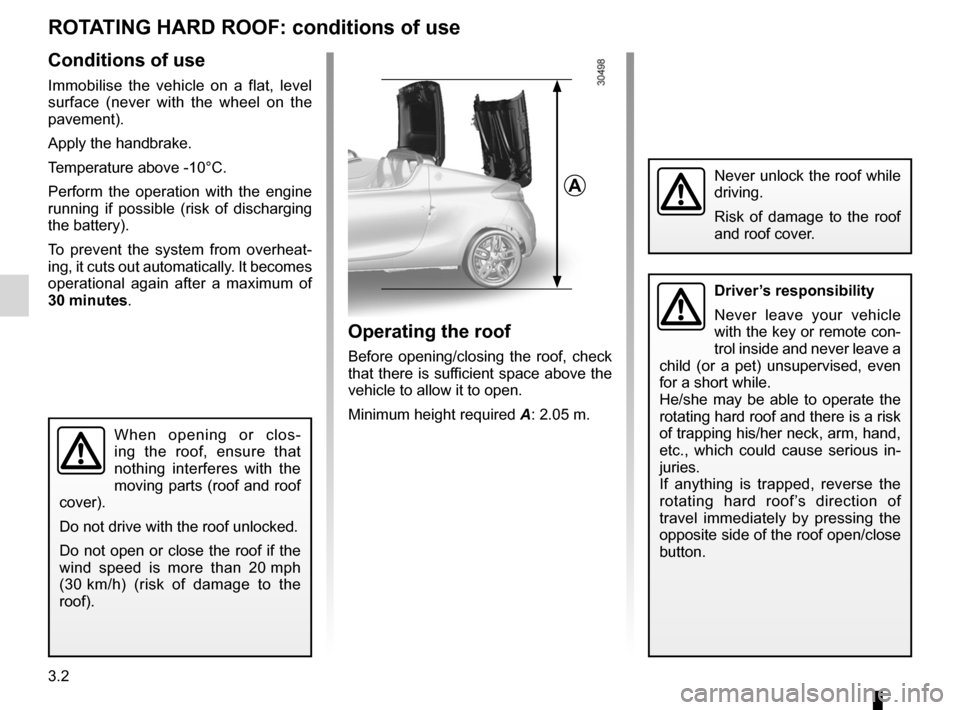
3.2
ENG_UD20475_2
Toit rigide escamotable : condition d’utilisation (E33 - X33 - Renaul\
t)
ENG_NU_865-6_E33_Renault_3
Rotating hard roof
Rotating HaRD RooF: conditions of use
Conditions of use
Immobilise the vehicle on a flat, level
surface (never with the wheel on the
pavement).
Apply the handbrake.
Temperature above -10°C.
Perform the operation with the engine
running if possible (risk of discharging
the battery).
To prevent the system from overheat -
ing, it cuts out automatically. It becomes
operational again after a maximum of
30 minutes.
When opening or clos -
ing the roof, ensure that
nothing interferes with the
moving parts (roof and roof
cover).
Do not drive with the roof unlocked.
Do not open or close the roof if the
wind speed is more than 20 mph
(30 km/h) (risk of damage to the
roof).
Driver’s responsibility
Never leave your vehicle
with the key or remote con-
trol inside and never leave a
child (or a pet) unsupervised, even
for a short while.
He/she may be able to operate the
rotating hard roof and there is a risk
of trapping his/her neck, arm, hand,
etc., which could cause serious in -
juries.
If anything is trapped, reverse the
rotating hard roof’s direction of
travel immediately by pressing the
opposite side of the roof open/close
button.
Never unlock the roof while
driving.
Risk of damage to the roof
and roof cover.
operating the roof
Before opening/closing the roof, check
that there is sufficient space above the
vehicle to allow it to open.
Minimum height required A: 2.05 m.
a
Page 98 of 185

3.14
ENG_UD11200_1
Air conditionné automatique (E33 - X33 - Renault)
ENG_NU_865-6_E33_Renault_3
Jaune NoirNoir texte
autoMatiC CliMate ContRol (3/6)
adjusting automatic mode
The system normally operates in auto-
matic mode but you can alter the stand-
ard settings used by the system (air
distribution, etc.). These options are
explained on the following pages.
automatic mode is the recom -
mended mode of use
In most cases, the automatic cli -
mate control system ensures a com-
fortable temperature in the passen -
ger compartment, while maintaining
good visibility and optimising fuel
consumption.
The types of adjustments that can
be made are described in the follow -
ing pages.
Return to automatic mode as soon
as possible.
The displayed temperature values
show a comfort level.
When starting the engine, increas -
ing or decreasing the value dis -
played will not allow the com -
fort level to be reached any more
quickly. The system will always op-
timise the temperature increase or
decrease (the ventilation system
does not start instantly at maximum
speed: it gradually increases). This
may take several minutes.
Generally speaking, unless there is
a particular reason not to, the dash-
board air vents should remain open.
Page 100 of 185
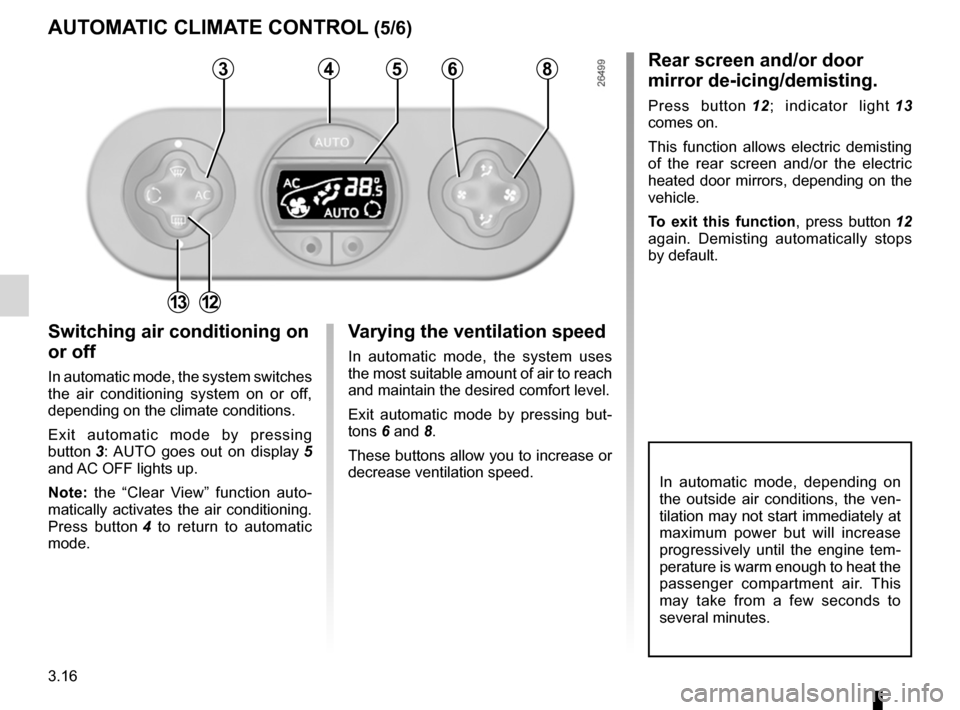
3.16
ENG_UD11200_1
Air conditionné automatique (E33 - X33 - Renault)
ENG_NU_865-6_E33_Renault_3
Jaune NoirNoir texte
autoMatiC CliMate ContRol (5/6)
In automatic mode, depending on
the outside air conditions, the ven-
tilation may not start immediately at
maximum power but will increase
progressively until the engine tem -
perature is warm enough to heat the
passenger compartment air. This
may take from a few seconds to
several minutes.
switching air conditioning on
or off
In automatic mode, the system switches
the air conditioning system on or off,
depending on the climate conditions.
Exit automatic mode by pressing
button 3 : AUTO goes out on display 5
and AC OFF lights up.
n ote: the “Clear View” function auto -
matically activates the air conditioning.
Press button 4 to return to automatic
mode.
v arying the ventilation speed
In automatic mode, the system uses
the most suitable amount of air to reach
and maintain the desired comfort level.
Exit automatic mode by pressing but -
tons 6 and 8.
These buttons allow you to increase or
decrease ventilation speed.
Rear screen and/or door
mirror de-icing/demisting.
Press button 12 ; indicator light 13
comes on.
This function allows electric demisting
of the rear screen and/or the electric
heated door mirrors, depending on the
vehicle.
t o exit this function, press button 12
again. Demisting automatically stops
by default.
4568
13
3
12
Page 102 of 185

air conditioning ..................................... (up to the end of the DU)
heating system ..................................... (up to the end of the DU)
air conditioning ..................................... (up to the end of the DU)
temperature regulation ......................... (up to the end of the DU)
ventilation ............................................. (up to the end of the DU)
heating and air conditioning system ...................... (current page)
3.18
ENG_UD11524_2
Air conditionné : informations et conseils d’utilisation (X77 ph2\
- Renault)
ENG_NU_865-6_E33_Renault_3
aiR ConDitioning: information and advice on use
Fuel consumption
You will normally notice an increase
in fuel consumption (especially
when driving in town) when the air
conditioning is operating. For vehi -
cles fitted with manual air condition -
ing, switch off the system when it is
not required.
advice for reducing consumption
and therefore helping to preserve
the environment:
Drive with the air vents open and
the windows closed.
If the vehicle has been parked in
the sun, open the doors for a few
moments to let the hot air escape
before starting the engine.
Maintenance
Refer to the Maintenance Document
for your vehicle for the inspection
frequency.
Do not open the refriger -
ant fluid circuit. The fluid
may damage eyes or skin.
note
Presence of water under the ve -
hicle. After prolonged use of the air
conditioning system, it is normal for
water to be present under the vehi-
cle. This is caused by condensation.
operating faults
As a general rule, contact your ap-
proved Dealer in the event of an op-
erating fault.
– Reduction in de-icing, demist -
ing or air conditioning per -
formance . This may be caused
by the passenger compartment
filter cartridge becoming clogged.
– no cold air is being produced.
Check that the controls are set
correctly and that the fuses are
sound. Otherwise, switch off the
system.
Do not add anything to the
vehicle’s ventilation circuit
(for example, to remove
bad odours).
t here is a risk of damage or of
fire.
Page 103 of 185
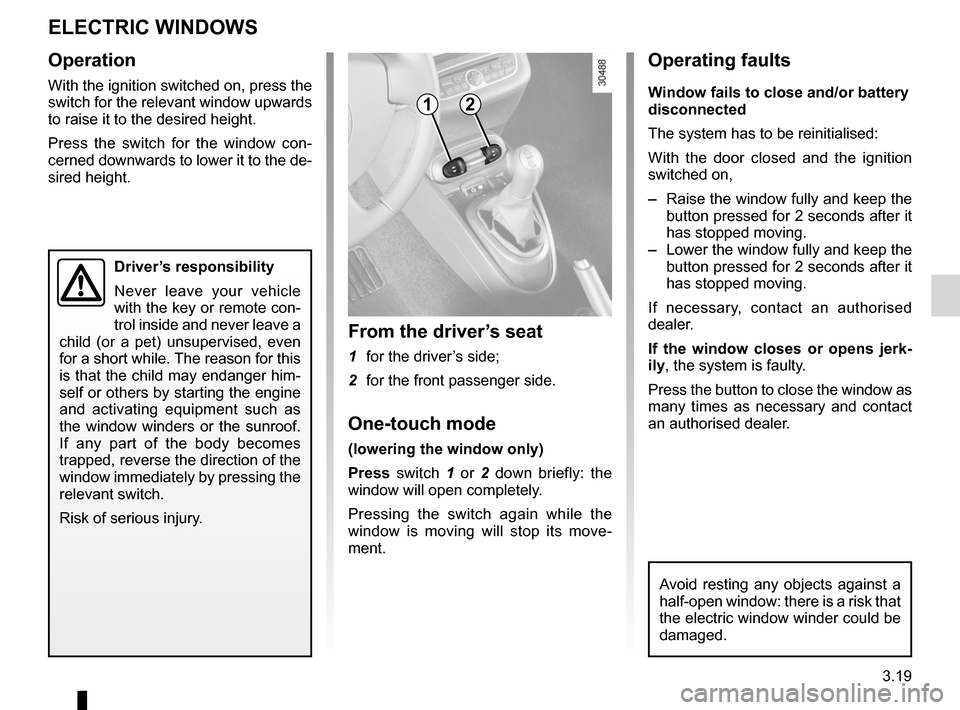
electric windows ................................... (up to the end of the DU)
child safety ............................................................. (current page)
children (safety) ..................................................... (current page)
sunroof .................................................. (up to the end of the DU)
3.19
ENG_UD24366_2
Lève-vitres électriques (E33 - X33 - Renault)
ENG_NU_865-6_E33_Renault_3
Electric windows
eleCtRiC winDows
operation
With the ignition switched on, press the
switch for the relevant window upwards
to raise it to the desired height.
Press the switch for the window con -
cerned downwards to lower it to the de-
sired height.
From the driver’s seat
1 for the driver’s side;
2 for the front passenger side.
one-touch mode
(lowering the window only)
Press switch 1 or 2 down briefly: the
window will open completely.
Pressing the switch again while the
window is moving will stop its move -
ment.
Avoid resting any objects against a
half-open window: there is a risk that
the electric window winder could be
damaged.
1
Driver’s responsibility
Never leave your vehicle
with the key or remote con-
trol inside and never leave a
child (or a pet) unsupervised, even
for a short while. The reason for this
is that the child may endanger him-
self or others by starting the engine
and activating equipment such as
the window winders or the sunroof.
If any part of the body becomes
trapped, reverse the direction of the
window immediately by pressing the
relevant switch.
Risk of serious injury.
2
operating faults
w indow fails to close and/or battery
disconnected
The system has to be reinitialised:
With the door closed and the ignition
switched on,
– Raise the window fully and keep the
button pressed for 2 seconds after it
has stopped moving.
– Lower the window fully and keep the
button pressed for 2 seconds after it
has stopped moving.
If necessary, contact an authorised
dealer.
i f the window closes or opens jerk -
ily, the system is faulty.
Press the button to close the window as
many times as necessary and contact
an authorised dealer.
Page 111 of 185

4.1
ENG_UD29997_7
Sommaire 4 (E33 - X33 - Renault)
ENG_NU_865-6_E33_Renault_4
Section 4: Maintenance
Bonnet . . . . . . . . . . . . . . . . . . . . . . . . . . . . . . . . . . . . . . . . . . . . . . . . . . . . . . . . . . . . . . . . . . . . . . . . 4.2
Engine oil level: . . . . . . . . . . . . . . . . . . . . . . . . . . . . . . . . . . . . . . . . . . . . . . . . . . . . . . . . . . . . . . . . . 4.4
general information . . . . . . . . . . . . . . . . . . . . . . . . . . . . . . . . . . . . . . . . . . . . . . . . . . . . . . . . 4.4
topping up/filling . . . . . . . . . . . . . . . . . . . . . . . . . . . . . . . . . . . . . . . . . . . . . . . . . . . . . . . . . . . 4.5
Engine oil change . . . . . . . . . . . . . . . . . . . . . . . . . . . . . . . . . . . . . . . . . . . . . . . . . . . . . . . . . . . . . . . 4.6
Levels: . . . . . . . . . . . . . . . . . . . . . . . . . . . . . . . . . . . . . . . . . . . . . . . . . . . . . . . . . . . . . . . . . . . . . . . . 4.7
engine coolant . . . . . . . . . . . . . . . . . . . . . . . . . . . . . . . . . . . . . . . . . . . . . . . . . . . . . . . . . . . . 4.7
brake fluid . . . . . . . . . . . . . . . . . . . . . . . . . . . . . . . . . . . . . . . . . . . . . . . . . . . . . . . . . . . . . . . . 4.8
windscreen washer reservoir . . . . . . . . . . . . . . . . . . . . . . . . . . . . . . . . . . . . . . . . . . . . . . . . . 4.9
Filters . . . . . . . . . . . . . . . . . . . . . . . . . . . . . . . . . . . . . . . . . . . . . . . . . . . . . . . . . . . . . . . . . . . . . . . . . 4.9
Tyre pressure. . . . . . . . . . . . . . . . . . . . . . . . . . . . . . . . . . . . \
. . . . . . . . . . . . . . . . . . . . . . . . . . . . . . . 4.10
Battery . . . . . . . . . . . . . . . . . . . . . . . . . . . . . . . . . . . . . . . . . . . . . . . . . . . . . . . . . . . . . . . . . . . . . . . . 4.11
Bodywork maintenance . . . . . . . . . . . . . . . . . . . . . . . . . . . . . . . . . . . . . . . . . . . . . . . . . . . . . . . . . . . 4.12
Interior trim maintenance . . . . . . . . . . . . . . . . . . . . . . . . . . . . . . . . . . . . . . . . . . . . . . . . . . . . . . . . . . 4.14